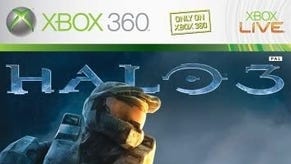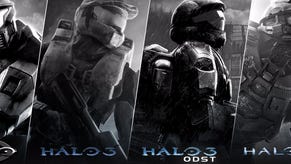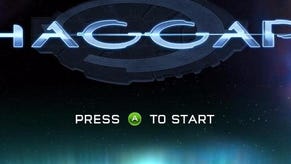Can Halo 4 capture the series' spark?
343's made an authentic Halo game, but the jury's out whether it has an identity of its own.
It's Halo. I don't know why I was so surprised by that, but Halo 4 feels very much like another Halo game. There's the spongy movement, that wonderful combat loop and a sense of pomp and scale so grand you can't help but be carried away in its ridiculous sweep. There are shrill aliens, both squat and tall, and gunfire that sends multi-coloured traces across strange landscapes.
Actually, I do know why I was kind of surprised. This is the first post-Bungie Halo, and in the PR drumbeat that's been getting ever more intense it's been easy to wonder whether 343's idea of Halo chimes with what everyone else's idea of Halo is - or what mine is, at least. There was even a time, just after the initial announcement, when I worried if Halo 4 would even be a first-person shooter - that 343 would feel the need to make its mark by taking the series on a new path and fashion it into a Dead Space-style action horror game.
A dumb notion, but playing through the introduction of Halo 4's campaign it turns out I was kind of right to be cautious. For the first time that I can recall in a Halo game there's a quick-time event, and a fairly pronounced one at that. As Master Chief works his way through the battered innards of the spaceship Forward Unto Dawn he's blasted down a lift shaft. His recovery, told in first-person, requires you to push up on the analogue stick to progress, occasionally tapping left or right to dodge falling debris.
Like many other quick-time events, it's clumsy, the connection between the player and the game being forced into something that's a little too tenuous. With the rest of the tutorial sticking to Halo's well-established path - at first it's a homage to Combat Evolved's Pillar of Autumn, as you work through steel tunnels that are spectacularly eating themselves, and when you step outside into a muted, low-gravity exterior it's an obvious tribute to Halo 2's The Armory - it's the first time that 343's fingerprints are felt on Halo's formula, and they're in danger of soiling it.
It's a fleeting moment, though, and by the second half of the play-through - culled from the third mission in Halo 4's campaign - 343 seems to have found its feet, mimicking the combat loop from previous games and splicing in a number of significant additions headed up by the new kids in town, the Prometheans. As enemies, they interfere with the established patterns of play. Knights are the new Elites, essentially, perched near the top of Halo's food chain and posing an agile, intelligent threat. They're circled by Watchers, flying drones shielding foot-soldiers that, it soon becomes apparent, are the first priority in most scraps.
Promethean weaponry also adds another flavour, even if the new guns exist within well-established classes. The Suppressor works like an SMG, delivering sharp bursts of light fire, while the Scattershot's a shotgun whose shells bounce deliriously across solid surfaces. The Boltshot's a slightly different proposition, initially resembling the Mauler before revealing itself to have a little more nuance - hold down the trigger and the muzzle flares open for a charged shot akin to that on the Covenant's plasma pistol. They're familiar but different, then, and it's a welcome sign that getting your hands on the previously alien Covenant weaponry now feels just like coming home.
Halo 4's introductions are subtle enough to make that core combat loop feel just as familiar, though it's lost none of its shine. There's still the potential for emergent moments that can live longer in the memory than any cut-scene or set-piece, and a couple of hours with Halo 4 churns up a few of its own - gleefully taking to a field of battling Covenant and Prometheans with a Ghost or, in the Spartan Ops co-op mode, bursting through a gaggle of nervous comrades to finish off a Wraith with my bare fists.
They're true Halo moments, though I'm left afterwards thinking they're the kind I could happily recreate by simply booting up either Reach or Halo 3. 343's got the main formula down pat, but there's a nagging feeling that the additions may not be meaningful, and that a little of that indefinable Bungie magic's been lost. The landscapes are strange and beautiful but they don't yet have that same sense of wonder, the weapons are inventive and satisfying but there's a suspicion that they're muddying the pure pool of previous games.
I also worry that my cynicism stems from too long spent in Bungie's thrall and a reluctance to embrace Halo's new masters, as well as the inevitable fatigue that sets in when playing a late-generation entry to a well-established series. Despite the best work of 343's artists, the Xbox 360 can't provoke the awe that it once did, a fact not helped when we're playing the code with our noses squashed flat against 40-inch screens.
But so much of what 343's doing with Halo 4 deserves applause. Spartan Ops, the episodic series that's going to be delivered in a weekly cadence, thus hoping to be consumed in the same way that we consume TV shows, is a smart way of adding value. It's also one that a brief hands-on suggests is an awful lot of fun. Master Chief's return also carries a certain weight, and 343's handling of this icon is nothing less than assured.
343's done a hell of a job aping Bungie's formula while creating some smart additions of its own. It's made a real Halo game, and that's an achievement in itself, but I'll have to wait until November to see if that's enough to make this instalment feel as special as its predecessors.





























